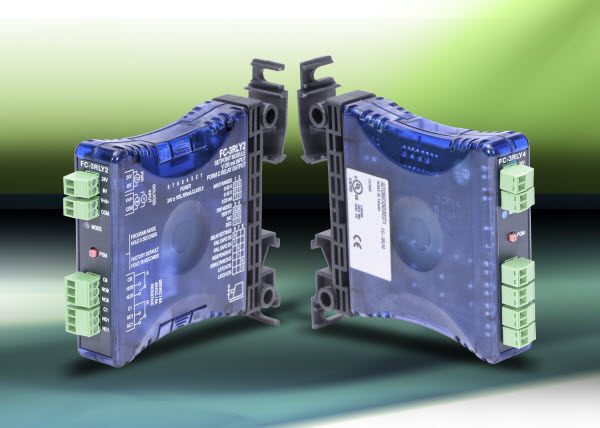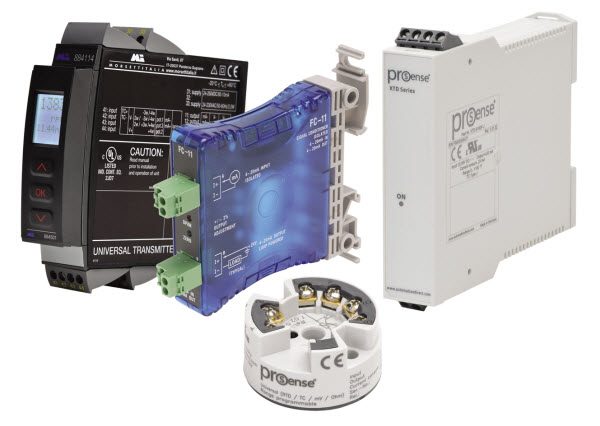Discrete and analog field devices provide the bulk of information to control, monitoring and data acquisition systems. Connecting these devices with the proper signal level and without any issues is therefore critical. Fortunately, signal conditioners can smooth or change the signal, address issues, and even provide some simple logic.
Signal conditioners often eliminate the need to change the field device or add a different analog input card at the controller. Whether the need is to convert a velocity command to a servo drive, convert a voltage to a current, or change to a bipolar signal—signal conditioners can fit the bill. As an added benefit, signal isolation is commonly offered to minimize voltage transients, spikes and other electrical noise.
Have Signal, Will Change
There’s a wide variety of signal conditioners available performing signal conversion, isolation and retransmission. Some common types include:
- DC Voltage or Current Input
- Universal Input
- Temperature
- Thermocouple Input
- RTD Input
- Programmable Temperature Transmitters (T/C or RTD Input)
- High Speed Optical Isolators for encoder inputs
- Limit Alarms
It’s safe to say that if you need to change a voltage or current to some other signal level, a signal converter is available to perform that task. Common analog signals can be converted to any other signal level, with or without isolation. With some signal conditioners, isolation may be the only purpose, such as eliminating sinking and sourcing issues, or ground loops.
Whether unipolar or bipolar, there are voltage converters, current converters or cross converters that can change +/-100 mVdc, +/-50 mVdc, +/-5 Vdc, +/-10 Vdc, +/-15 Vdc, 0-20 mA, 4-20 mA, 0-10 Vdc or 0-5 Vdc to just about any other signal level, often with calibration features such as zero and span adjustment.
Universal signal conditioners handle voltage and current conversions and add thermocouple, RTD and potentiometer input capability. Some include programmable signal conversion, scaling and process calibration to simplify installation and commissioning.
Converting Temperature Signals
Temperature transmitters are probably the most popular signal conditioner. Converting a mV range temperature signal to 4-20mA significantly reduces signal loss, eliminates the need for special thermocouple or RTD wiring, and eliminates the need for a specialty input module by allowing use of standard analog input modules.
Temperature transmitters may be specified for a single type of thermocouple such as a type J input or a single RTD such as a 3-wire Pt100 RTD input, or specified as a universal programmable temperature transmitter with a RTD or thermocouple input. Universal programmable temperature transmitters convert just about any temperature input to a scaled 4-20 mA output analog output, and can be programmed with AutomationDirect’s free ProSense XT-SOFT software.
Setting Limits
 A limit alarm signal conditioner converts a signal input high or low level to a discrete signal output to augment control system capabilities. For example, a two-output conditioner can be configured to detect a high level condition and signal an alarm, and then, as the input increases, detect an overflow condition and close a valve. It can also provide signals to two separate devices based on the same input condition, such as a local alarm horn and a PLC input.
A limit alarm signal conditioner converts a signal input high or low level to a discrete signal output to augment control system capabilities. For example, a two-output conditioner can be configured to detect a high level condition and signal an alarm, and then, as the input increases, detect an overflow condition and close a valve. It can also provide signals to two separate devices based on the same input condition, such as a local alarm horn and a PLC input.
Limit alarm signal conditioners are often configured to actuate alarms based on increasing or decreasing signal levels, and can also be configured for failsafe operation. Latching outputs with a separate manual reset are also available. Limit alarm signal conditioners are configured using adjustable potentiometer set points, pushbuttons and DIP switches.
A high speed optical isolator signal conditioner converts digital encoder signal inputs to open collector or differential line driver outputs, very useful when the encoder doesn’t match the controller’s input signal levels, a common occurrence.
Take a careful look at the wide range of signal conditioners available as there’s a good chance one exists to fix just about any signal level problem. If electrical signals from field devices don’t match with control system inputs, AutomationDirect probably has a signal converter to address the issue.



